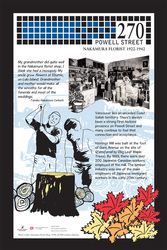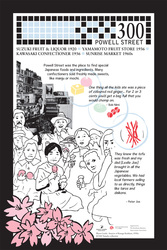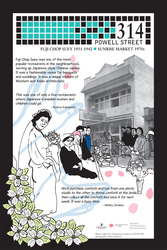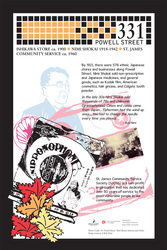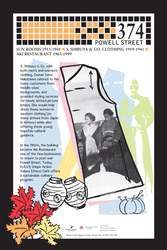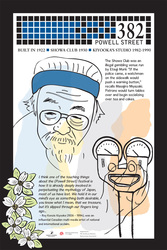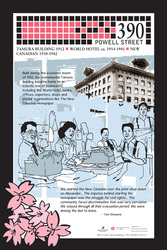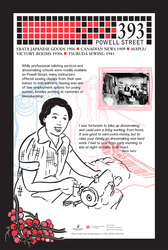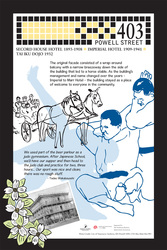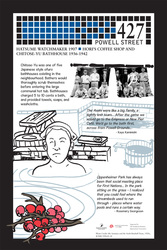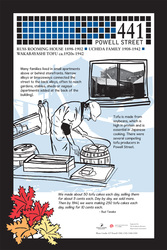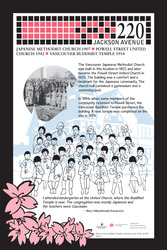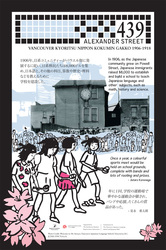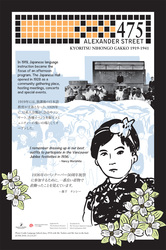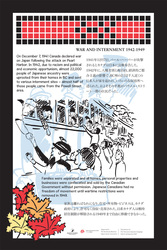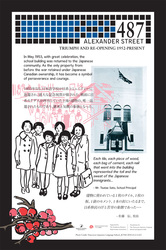Artist Statement
The series of 16 panels is designed to tell a non-linear graphic memoir of Powell Street. Each design draws on the aesthetics of traditional Japanese hanafuda flower cards, and in this contemporary rendition repeats the four seasonal B.C. flora motifs of maple leaf, saskatoon berry, cherry blossom, and dogwood flower.
Placed along the 300 and 400 blocks of Powell Street are 12 panels, with an additional set of 4 panels at the 400 block of Alexander Street at the Vancouver Japanese Language School and Hall. The panels become a point of reference; a permanent but short entry point into the historical narratives that make up this neighborhood that was once known as "Paueru-gai." Until 1942 the neighborhood was the social and economic centre for Japanese Canadians throughout B.C. and ‘home’ for two generations of Japanese Canadians - around half of the 22,000 of the time.[1] Though it was "home" to many it was also a space of segregation within the city; "Little Tokyo," or "Japtown" as the more hostile termed it. This naming of a neighborhood was both a physical and a social marker, not just the site itself but on the bodies that resided and used this space. Vancouver's Powell Street was the focal point for Japanese activities and was a physical segregation as it was psychical. “And from the physical, the immigrants gained a deep consciousness of their separateness. The area was apart as if a ghetto wall defined it. It was possible to shop at Japanese-owned stores, to live in Japanese-operated boarding houses or hotels, to congregate at street corners, to sit in soft drink and ice cream parlours, to eat traditional Japanese foods in cafes, to go to the Japanese language school and hall close by, to watch the local athletic teams play on the sandlot, to worship in Buddhist temple or Christian church.”[2]
Placed along the 300 and 400 blocks of Powell Street are 12 panels, with an additional set of 4 panels at the 400 block of Alexander Street at the Vancouver Japanese Language School and Hall. The panels become a point of reference; a permanent but short entry point into the historical narratives that make up this neighborhood that was once known as "Paueru-gai." Until 1942 the neighborhood was the social and economic centre for Japanese Canadians throughout B.C. and ‘home’ for two generations of Japanese Canadians - around half of the 22,000 of the time.[1] Though it was "home" to many it was also a space of segregation within the city; "Little Tokyo," or "Japtown" as the more hostile termed it. This naming of a neighborhood was both a physical and a social marker, not just the site itself but on the bodies that resided and used this space. Vancouver's Powell Street was the focal point for Japanese activities and was a physical segregation as it was psychical. “And from the physical, the immigrants gained a deep consciousness of their separateness. The area was apart as if a ghetto wall defined it. It was possible to shop at Japanese-owned stores, to live in Japanese-operated boarding houses or hotels, to congregate at street corners, to sit in soft drink and ice cream parlours, to eat traditional Japanese foods in cafes, to go to the Japanese language school and hall close by, to watch the local athletic teams play on the sandlot, to worship in Buddhist temple or Christian church.”[2]
The duality of the space; its contradictions and its ability to both include and exclude form a complicated framework for commemorative panels. The context to which this project is framed has also added another questioning - as to who the audience might be? When the panels are situated to mark storefronts of businesses, who stops to take part in the acts of commemoration?
The 2011 Open Doors panels that I have created combine a mixture of illustration, oral histories, and archival photographs to provide an entry point into the layered and complex memories and histories of the social and commercial spaces that were used by the Japanese Canadian community and other residents before and after the war. This mixing, of both the history and the playfulness of traced line drawing, forms a post-memory narrative; told by the generation directly removed from the experience of the Japanese Canadian internment and trauma itself. The content has been developed by working through what is re-told through both mass media and the stories and silences of the previous generations.[3] I hope that these panels offer a gesture of remembrance that can be engaged through a self-guided walk through the neighborhood or alongside other guided historical walking tours.
By walking along this section of Powell Street, viewers can experience the tracing of a narrative that offers and sketches a memory of the neighborhood from 1900s to present day. By no means a complete narrative, the walking subject shapes his/her own experience of the space through their individual encounter with each or some of these graphic panels in an order they conceive and chart by their own individual experience.
- Cindy Mochizuki
Reference:
[1] Kobayashi, Audrey. Memories of Our Past: a brief history and walking tour of Powell Street. Vancouver: NRC Publishing. 1992.
[2] Adachi, Ken. The Enemy that Never Was: A History of the Japanese Canadians. Toronto: McClelland and Stewart,1976
An account of the deplorable treatment inflicted on Japanese Canadians during the World War Two. (131).
[3] Hirsch, Marianne. “Mourning and Postmemory,” and “Past Lives,” Family Frames: Photography, Narrative, and Postmemory. Cambridge: Harvard University Press. 1997. (22).
The 2011 Open Doors panels that I have created combine a mixture of illustration, oral histories, and archival photographs to provide an entry point into the layered and complex memories and histories of the social and commercial spaces that were used by the Japanese Canadian community and other residents before and after the war. This mixing, of both the history and the playfulness of traced line drawing, forms a post-memory narrative; told by the generation directly removed from the experience of the Japanese Canadian internment and trauma itself. The content has been developed by working through what is re-told through both mass media and the stories and silences of the previous generations.[3] I hope that these panels offer a gesture of remembrance that can be engaged through a self-guided walk through the neighborhood or alongside other guided historical walking tours.
By walking along this section of Powell Street, viewers can experience the tracing of a narrative that offers and sketches a memory of the neighborhood from 1900s to present day. By no means a complete narrative, the walking subject shapes his/her own experience of the space through their individual encounter with each or some of these graphic panels in an order they conceive and chart by their own individual experience.
- Cindy Mochizuki
Reference:
[1] Kobayashi, Audrey. Memories of Our Past: a brief history and walking tour of Powell Street. Vancouver: NRC Publishing. 1992.
[2] Adachi, Ken. The Enemy that Never Was: A History of the Japanese Canadians. Toronto: McClelland and Stewart,1976
An account of the deplorable treatment inflicted on Japanese Canadians during the World War Two. (131).
[3] Hirsch, Marianne. “Mourning and Postmemory,” and “Past Lives,” Family Frames: Photography, Narrative, and Postmemory. Cambridge: Harvard University Press. 1997. (22).
